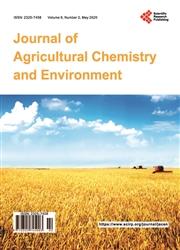Effects of Calcium Nitrate Levels and Soaking Durations on Cocopeat Nutrient Content
引用次数: 3
Abstract
Cocopeat, a by-product of the coconut (Cocos nucifera L.), is an important soilless media that contains high potassium (K), sodium (Na), and electrical conductivity (EC) depending on its source. Methods for extracting these elements and thus lowering EC are yet to be standardized. This study was therefore carried out to investigate two extraction methods of these elements in cocopeat. A greenhouse pot experiment was carried out at the Climate and Water Smart Agriculture Centre of Egerton University, Kenya. It was laid out in a 5 × 4 factorial completely randomized design. Five soaking durations (12, 24, 36, 48, and 72 hours) and four calcium nitrate (Ca(NO3)2) levels (0, 60, 100, and 150 g) were used. The experiment was done in two folds: the leachate and treated cocopeat examination for their chemical properties. The General Linear Model procedures were used for Analysis of Variance at (P ≤ 0.05). The results showed that the addition of Ca(NO3)2 100 g extracted significantly more K and Na in the leachate than Ca(NO3)2 0.0 g and 60 g. The EC levels in the leachate increased with the application levels of Ca(NO3)2 while the pH levels were reducing. In the treated cocopeat, Ca(NO3)2 100 g and soaking duration 36 hours significantly reduced K and Na and sufficiently supplemented Ca and N. Irrespective of Ca(NO3)2 and soaking durations, after the cocopeat is washed, the EC and pH values fall within their suitable ranges. There was a strong negative correlation between Ca and Na, Ca and K, and between Na and EC. Also, strong positive correlation between Ca and N and Ca and EC. Effective supplementation of Ca and N, and optimal reduction of K and Na by 78.44% and 92%, respectively can be achieved with 100 g of Ca(NO3)2 1.5 kg-1 of cocopeat in 15 liters of water with a soaking duration of 36 hours.硝酸钙水平和浸泡时间对椰肉养分含量的影响
椰油是椰子(Cocos nucifera L.)的副产品,是一种重要的无土培养基,它含有高钾(K)、高钠(Na)和高导电性(EC),这取决于它的来源。提取这些元素从而降低EC的方法尚未标准化。因此,本研究对椰子中这些元素的两种提取方法进行了研究。肯尼亚埃格顿大学气候与水资源智能农业中心进行了一项温室盆栽试验。试验采用5 × 4因子完全随机设计。5个浸泡时间(12、24、36、48和72小时)和4个硝酸钙(Ca(NO3)2)水平(0、60、100和150 g)。实验分为渗滤液和处理后的鸡粪两部分,对其化学性质进行了考察。方差分析采用一般线性模型程序(P≤0.05)。结果表明,添加Ca(NO3)2 100 g显著高于Ca(NO3)2 0.0 g和60 g。随着Ca(NO3)2施用量的增加,渗滤液中EC含量呈上升趋势,pH值呈下降趋势。在处理后的椰肉中,Ca(NO3)2 100 g和浸泡时间36 h显著降低了K和Na,充分补充了Ca和n。无论Ca(NO3)2和浸泡时间如何,椰肉洗涤后的EC和pH值都在适宜范围内。Ca与Na、Ca与K、Na与EC呈显著负相关。Ca与N、Ca与EC呈显著正相关。以1.5 kg-1的Ca(NO3)浓度为100 g,浸泡15升水,浸泡36小时,可获得Ca和N的有效补充,K和Na的最佳还原率分别为78.44%和92%。
本文章由计算机程序翻译,如有差异,请以英文原文为准。
求助全文
约1分钟内获得全文
求助全文

 求助内容:
求助内容: 应助结果提醒方式:
应助结果提醒方式:


